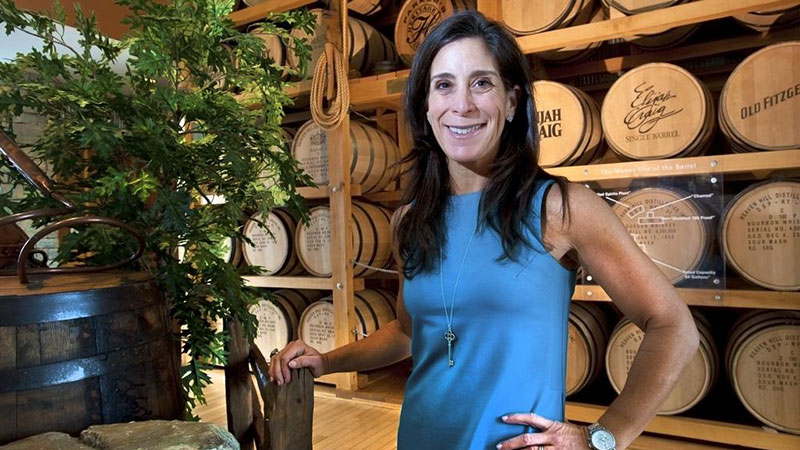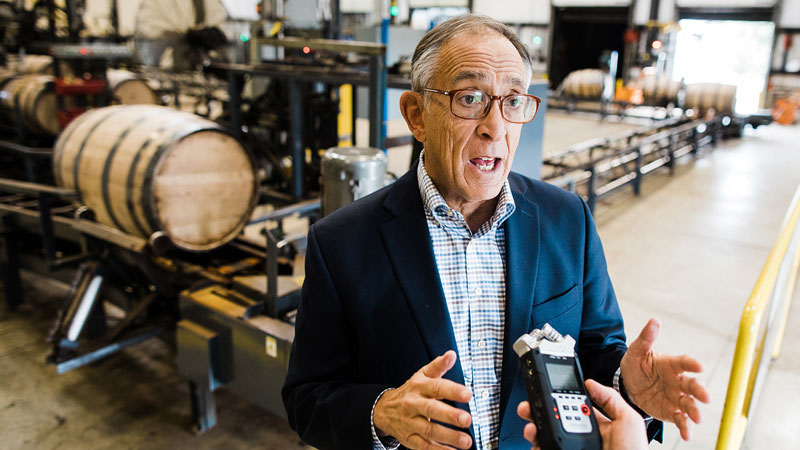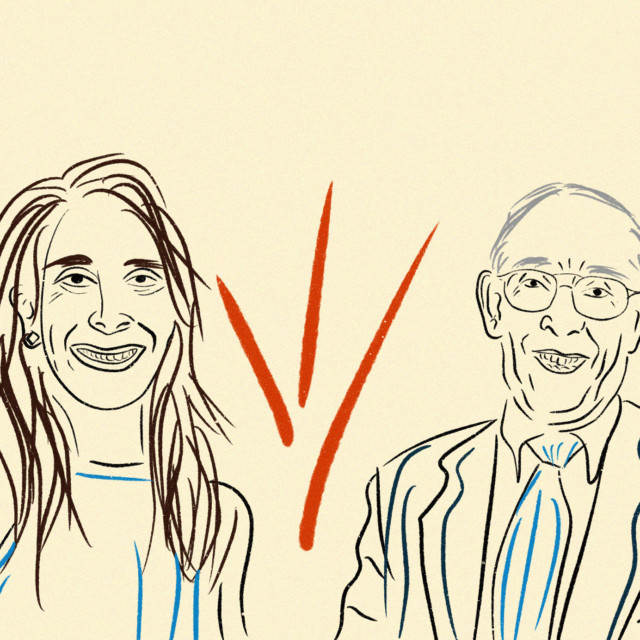Heaven Hill stands as an outlier in Kentucky’s great bourbon industry. Sure, many of its whiskey-making neighbors in the Bluegrass State also boast multi-generational family histories, but Heaven Hill remains the state’s only legacy distiller that continues to be entirely family owned and operated.
This isn’t the only area in which Heaven Hill stands out. In its 80-plus-year history, the company has diversified beyond American whiskey more than almost all of its competitors — certainly those that remain rooted and headquartered in Kentucky.
Though you’ll find a whiskey bearing its name on liquor store shelves, that hasn’t always been the case. Even now, many of its most iconic and beloved bourbon brands are those Heaven Hill has bought and developed over the years, often somewhat accidentally.
Descendents of a Lithuanian immigrant, the Shapiras are the family behind this storied family of Heaven Hill brands. Founder Ed Shapira (along with his four brothers) entered the industry purely as a financial investor but soon found himself running a burgeoning distillery amid a financial crisis. His son and current president, Max, was set for a career on Wall Street before returning to the family business in 1970. And it was a similar story for third-generation Kate Shapira Latts, who pursued an MBA then worked for Procter & Gamble in Cincinnati, before joining Heaven Hill’s marketing team in 2001.
Some bourbon family legacies stretch back longer, while other names may be more immediately recognizable to casual whiskey consumers. But make no mistake about it: Heaven Hill’s tale is every ounce as family-centric as any other in bourbon.
Here is the story of the family behind Heaven Hill and its portfolio of iconic brands, told by Max Shapira and Kate Shapira Latts.
An Unlikely Bourbon Business
The story of Heaven Hill begins in the late 1800s with the original Max Shapira, grandfather of the company’s current-day president of the same name.
Kate: My great-grandfather came to the United States from Lithuania and settled in central Kentucky. He became a peddler, with a horse and carriage, selling thimbles and various other household things. He married a woman named Anna Berlin, they had five sons, and settled down and opened up a dry goods store. As his sons became grownups in their early 20s, the business was doing really well and was expanding. Each of the sons went out into additional small towns throughout central Kentucky and opened up additional stores.
My grandfather happened to be running the store in Bardstown in the early ‘30s as Prohibition was ending. A group of folks who wanted to start up a new distillery came to him and said, “Do you and your brothers want to put up capital to help us get this distillery up and running?”
Max: Our family got together and said, “Here’s $17,500.” In those days, that was really a lot of money and it was strictly a financial investment. We always jokingly say my dad and the rest of the family didn’t know a barrel from a box — they didn’t know anything about whiskey.
To invest in a project like that in the middle of the Depression, it was the riskiest of ventures you can imagine: Terrible economic times, there was no distillery, there was no warehouse, there was no inventory, there was no brand. And if you got into this [business], you couldn’t just make it today and sell it tomorrow. All you could see was money flowing out that you may never get a return on.
After about 18 months, the distillery was built, whiskey was being made and put in a warehouse. The individuals who had all this technical expertise came to my dad and said they had some personal financial difficulties that had nothing to do with the distillery, but they were either going to have to close the thing down, sell it to somebody else, or perhaps the family might be interested in buying out their interest.
For about 20-something thousand dollars, they bought the others out and now the family ended up owning the entire operation. But they didn’t know anything about how to run it. My dad was pretty industrious, a good judge of character, and a really hard worker. So he hired some really good people and spent huge quantities of time seeing if this thing could actually develop into something.
To make a real impression on the market, they waited and waited until the whiskey was four years of age and they brought out a brand called Old Heaven Hill Bottled-in-Bond Whiskey. When it was introduced in 1939, that whiskey quickly became the No. 1-selling bourbon in the state of Kentucky.

Nurturing Brands
Those good times would be short lived. Not long after Heaven Hill’s introduction, the United States entered the Second World War, which saw Kentucky bourbon production halted again, this time to produce alcohol for the war effort. Production uncertainties followed in the ‘50s, during the Korean War. An industry-wide inventory surplus then saw whiskey prices plummet at the dawn of the ‘60s, just as consumer preferences were changing. (Clear spirits: good. Aged spirits: old and boring.) When Max Shapira joined in 1970, the company was in need of fresh ideas. Some of his strategies would bring unexpected treasures.
M: Over the course of the many years that we’d been in business, we had developed some great relationships with distributors all around the country. They liked our style of operating and how we worked together collaboratively. So as the industry started to change, as consumers’ wants and desires expanded beyond American whiskey, we started to diversify our product line, because our distributors were asking for additional products from us.
We did part of that through internal product development. And then, along the way, we had a series of acquisitions and expanded our portfolio. Some of the largest brands we have in our portfolio, and also some of the most iconic, historical brands, we acquired.
K: Through the ‘70s and ‘80s, we started diversifying a lot into vodka, gin, rum, and tequila. I always say bourbon was the heart and soul of the company, even then, but the rest of our business was really the growth engine. There’s a lot of people in the United States with lots of different tastes, and diversification is important.
M: The first big acquisition was in 1989 from Seagram’s. At that time, what we were really interested in was Burnett’s Gin, which was part of the portfolio. If we had Burnett’s Gin we could bring out a sister brand called Burnett’s Vodka and that could possibly be successful.
But within that portfolio there was a small brand called Henry McKenna. It was a regional brand and we nurtured it for a number of years. And then just a few years ago, it got to the place where our 10 Year Bottled-in-Bond Henry McKenna won the best whiskey in the world from a number of different publications.
We made several other acquisitions along the way where some of the smaller brands in those acquisitions, not the key ones that we were looking at, became part of our portfolio, and we nurtured them until the time was right for us to bring them full force back into the marketplace.
In 1999, we had the acquisition of the Bernheim bourbon producing facility in Louisville and along with that came several brands, one of which was Old Fitzgerald.
Old Fitzgerald was a really old-line brand with a really great pedigree, a really great history, but not much had been done with it over the years, and business had declined. We kept it where it was already selling and nurtured it along the way. We could’ve discontinued it and used the whiskey for something else but we said, “This is a brand worth keeping. We don’t know exactly when we’re going to use it or how we’re going to use it, but it’s worth maintaining in our portfolio.”
Then just a few years ago, we said, “We’re going to redevelop this brand using some of the iconic bottles that were used back in the heyday of Old Fitzgerald. We’re going to go back to its original forte: bottled-in-bond bottle whiskey, and we’re going to bring it back with some unique ages — 9-year-old, 10-year-olds, 13, 14, and 15-year-old.”
We kept it alive, we fed it a little bit along the way with a bit of promotional stuff, and all of a sudden it grew up. It’s become quite successful and sought after, and we’re really pleased with how we did that.
I can share another example: Rittenhouse Rye Whiskey. When we bought it, it was hardly anything. But, again, it had a real great historical background, and along the way it became the darling of the mixology community. It’s become a hugely important brand for us today.
The process of “nurturing” and developing brands wasn’t reserved only for acquisitions. Evan Williams, an in-house cornerstone of the Heaven Hill portfolio, also saw changes over the years.
K: Even in 2001, Evan Williams was not a national product in terms of its age and its proof, [which goes back to] working with different distributors — they needed different types of offerings. So that was a standout decision. We said, “We can really put the muscle behind this, but it has to be a national brand so we can start promoting it on a national level.” It was a big thing. The next big thing was when we had to take the age statement off of Evan Williams, because it had been a 7-year-old [product]. And oh, the haranguing about that decision.
Then the same thing happened with Elijah Craig where, yes, it was a consistent national brand, but we had to make a real strategic decision: Did we want to have to continue to raise and raise and raise the price, because this was a 12- year-old product? Or should we take the age off? So that was back to the debating, the debating, the debating. But here we are; the acceleration of that brand has been tremendous.
M: Elijah Craig was [another] brand that we bought that was literally out of business. It took some years before we decided what we wanted to do with it. But of course today it’s a hugely successful and exciting product for us.
The Evolution of Bourbon and Consumers
While Heaven Hill would adapt to the changing preferences of drinkers, eventually interest returned to America’s native spirit. The rest, as they say, is history.
M: In the ‘80s and ‘90s, we started to see this germ of “maybe bourbon’s coming back.” We started with single-barrel products and then small-batch whiskeys. And then there was some innovation with new packaging that was more stylized. All of a sudden we found ourselves around the year 2000 and the beginning of this bourbon renaissance. It didn’t all come in one big tsunami wave; it came in bits and pieces, slowly moving forward, catching momentum along the way.
K: It’s been phenomenal to see the shift of consumer trends. When I came here, millennials were first coming of age, and they grew up on Sunny Delight and Capri Sun, and all the different flavors of Skittles and bubblegum. They wanted flavors. Then millennials started growing up and were like, “Hmm, maybe our palates are evolving and maturing. Maybe these things with more authenticity and history are an interesting place to explore.” And I think that really led to the renaissance and current explosion in the bourbon category.
M: Here we are in 2021 with tremendous amounts of innovation and excitement. … Today there are honey-based bourbons, apple-based bourbons — who would have thought that just a few years ago? If somebody in a marketing department 15 years ago had raised their hand and said, “I’ve got a good idea. I think we oughta have a honey-based bourbon,” probably the person who was the head of the marketing department would say, “Please excuse yourself from the meeting, that’s a crazy idea.”
But the interesting thing about where we are today is almost everything is domestic. There’s a good bit of business abroad, but if you’re traveling around the world and you go to your hotel bar and say, “I want a whiskey and water,” probably 99 times out of 100, you’re going to get Scotch.
We’re not looking to put those Scotch people out of business — they make great whiskeys — but if we take 2 or 3 percent of that market share — Oh, my! What a tremendous increase there’d be for the bourbon category.

Everything for the Family
As the largest independently owned and operated bourbon producer, what do family values bring to the table?
K: There is so much about how we approach our business that’s driven and permeated because we are family owned, from the decisions we can make for the long term to the nimbleness in making those decisions.
When I used to work at Procter & Gamble, there was a saying: “Everybody is somebody’s assistant.” You spent an inordinate amount of your time trying to prepare your internal decks to convince your higher-up to get on board with the idea. And then higher up and higher up [it would go].
M: We can row our own boat. We can make our own decisions. We don’t have Wall Street looking over our shoulders. We’re looking at this in a very long-term, generational way, not just every six months or every quarter or every year.
My dad always told me it was all about patience and perseverance. And that’s one of the things that still is a bedrock component of what we do today. It may be old fashioned, but here we are 85-plus years later, and we’re still talking about being patient but persevering and moving forward.
The Darkest Day
Those values — patience and perseverance — faced no tougher test than the period after Nov. 7, 1996, when a fire at Heaven Hill’s Bardstown facility caused cataclysmic damage.
M: It was a terrible day — a windy day, gray, overcast, with rain coming down and tremendous thunderstorms. It seemed to go on and on forever. And to this day, we still do not know what started the fire. There’s lots of speculation that it could have been a lightning strike, ‘cause there was plenty of lightning. It could have been wind blowing an electrical line on a building and it sparking in some way. But suffice it to say, it was a traumatic event where we lost any number of warehouses, about a hundred thousand barrels of whiskey, and our distillery as well.
We all met late in the evening when things had calmed down a bit, though it probably took 10 days for the fire to be totally put out. We said, “Well, fortunately, no one was injured. Let’s just get everybody here and we’ll continue to bottle. There’s no reason not to fill orders, we got tanks of whiskey up and ready to go. If we don’t have jobs for everybody, we’ll find something to do, maybe sweeping the floor or whatever, but we’ll find something to do.” And that’s what we did.
One of the things that happened on the second day says a lot about our industry — and maybe it’s different to any other industry in the country, though that’s a big statement. Basically, I started getting calls from our competitors — [companies] that we would kill and they would kill us just to sell the last 200-milliliter bottle in some small town, somewhere across the country. But the industry came to our rescue. I’m not going to ever, ever diminish that.
We were able to get some production capacity at one of our competitors. They were nice enough to let our master distiller, Parker Beam, supervise and make sure that the base was the taste that we needed. Others had some excess whiskey and we had a way to marry that in with some of ours.
I don’t know that many other industries would have reacted quite the same way. I mean, there were so many people who called and were helpful enough to let us move forward in a positive way. Now, 1996, it’s like a distant memory. I remember it, but it’s a long time ago.
